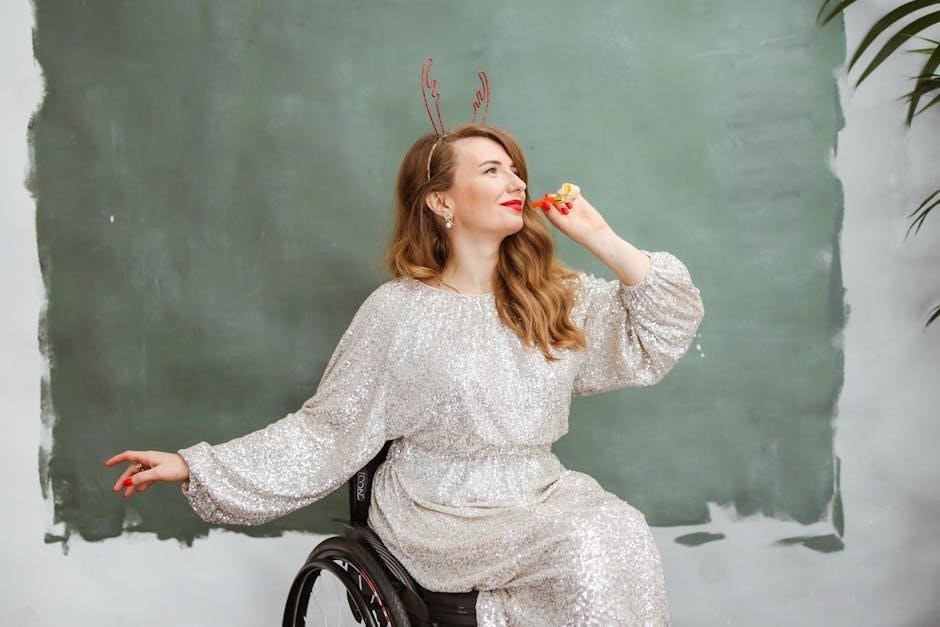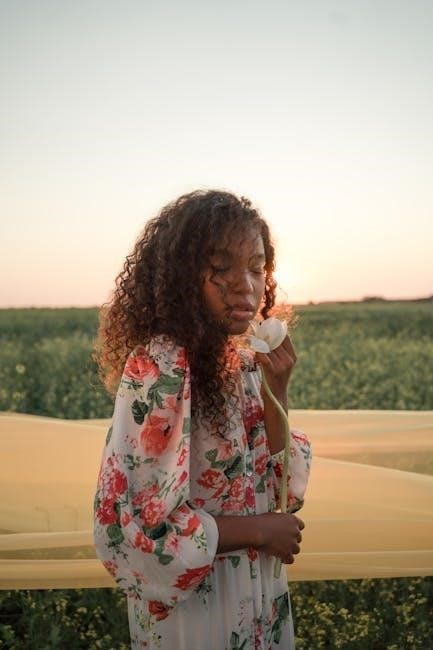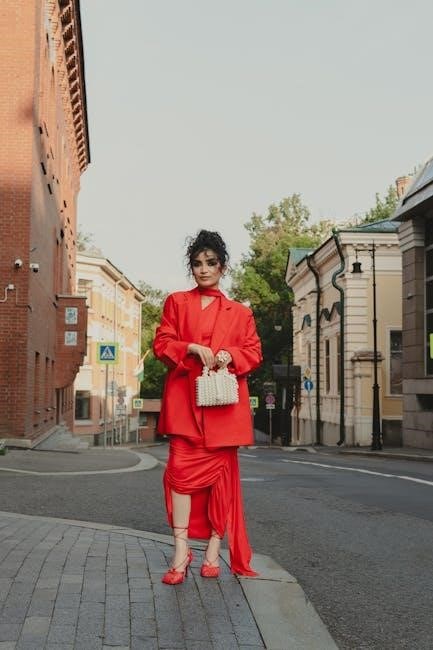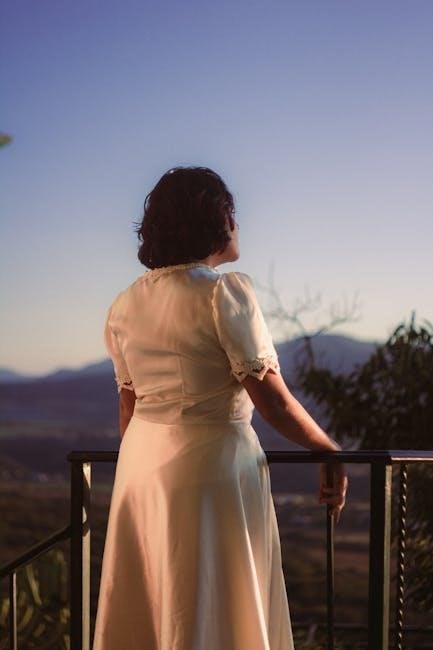“Five Women Wearing the Same Dress” by Alan Ball is a witty comedy set during a lavish Knoxville wedding. Five bridesmaids, each distinct, find refuge upstairs, exploring themes of identity and unity through their shared experiences and humorous interactions, revealing the complexities of female relationships with satire and heart.
Overview of the Play
“Five Women Wearing the Same Dress” is a comedy written by Alan Ball, set during an ostentatious wedding reception in Knoxville, Tennessee. The play follows five bridesmaids who retreat to Meredith’s bedroom to escape the chaos below. Each woman is uniquely distinct, with personalities ranging from rebellious to cynical, yet they share a common bond in their disconnect from the bride. Through their interactions, the play explores themes of identity, relationships, and societal expectations, blending humor and satire. The bridesmaids’ conversations reveal their individual struggles and camaraderie, offering a critique of marriage and societal norms. The play’s setting—a Victorian mansion—contrasts with the modern values of its characters, creating a backdrop for their irreverent and touching celebration of female solidarity.
Historical Context and Background
“Five Women Wearing the Same Dress,” written by Alan Ball in 1993, reflects the societal tensions of its time. The play critiques traditional gender roles and marriage norms, resonating with the early ’90s feminist dialogue. Set in Knoxville, Tennessee, it captures Southern cultural nuances, blending humor with social commentary. The Victorian mansion setting contrasts old-world values with modern perspectives, highlighting the characters’ struggles with identity and conformity. Ball’s work emerged during a period of growing theatrical experimentation, offering a fresh voice on women’s experiences. The play’s irreverent tone and satirical edge align with the era’s shift toward more progressive storytelling, making it a significant contribution to contemporary theater and feminist literature.
Alan Ball as the Playwright
Alan Ball, renowned for his work in television with hits like Six Feet Under and True Blood, showcased his storytelling prowess in “Five Women Wearing the Same Dress.” Written in 1993, the play highlights his ability to blend dark humor with poignant social commentary. Ball’s writing often explores themes of identity, societal expectations, and human complexity, all of which are central to this play. His nuanced portrayal of female characters and their interactions underscores his deep understanding of relational dynamics. Through this comedy, Ball critiques traditional norms while maintaining an engaging and entertaining narrative. His work continues to resonate, offering audiences a relatable yet thought-provoking experience that aligns with his reputation as a masterful storyteller.
Plot Summary
Set in Knoxville, Tennessee, during a lavish wedding reception, five bridesmaids escape to Meredith’s bedroom, discovering shared struggles and questioning the bride’s true character through witty dialogue.
Setting: The Wedding Reception in Knoxville, Tennessee

The story unfolds in a grand Victorian mansion in Knoxville, Tennessee, during an ostentatious wedding reception. Meredith’s bedroom, where the five bridesmaids seek refuge, reflects her rebellious personality through its eclectic decor. The room, with its Victorian bones but modern, personalized touches, serves as a sanctuary for the women. The mansion’s opulent setting contrasts sharply with the bridesmaids’ discomfort and their growing realization of the bride’s true nature. This juxtaposition of elegance and rebellion creates a rich backdrop for their humorous and heartfelt exchanges. The isolated bedroom setting allows the women’s true selves to emerge, making it the emotional core of the play.
The Five Bridesmaids and Their Roles

The five bridesmaids in Alan Ball’s play are distinct individuals, each with unique personalities and roles. Meredith, the bride’s rebellious sister, leads the group with her fiery spirit. Frances, a religious and sweet cousin, offers innocence and naivety, often providing comedic relief. Mindy, the blunt and outspoken friend, speaks her mind without filter, challenging the others. Georgeanne, cynical and sarcastic, brings a darker, world-weary perspective. Trisha, jaded and experienced, completes the group with her cynical views on marriage. Together, they form a diverse ensemble, each contributing to the play’s humor and depth. Their interactions reveal their individual struggles and collective realization of their disconnect from the bride, creating a dynamic and engaging narrative.
Conflict and Themes in the Play
The conflict arises as five bridesmaids, trapped in Meredith’s bedroom, escape the wedding reception they collectively disdain. Their shared discomfort in identical dresses symbolizes their stifled individuality. The play explores themes of identity, marriage, and societal expectations, as each woman’s backstory reveals struggles with self-discovery and relationships. Through humor and satire, Ball critiques traditional marriage and gender roles, highlighting the tension between personal aspirations and societal pressures. The bridesmaids’ camaraderie emerges as a counterpoint to their disillusionment, showcasing female solidarity amidst chaos. Their interactions expose vulnerabilities, insecurities, and the search for authenticity, making the play a poignant yet humorous commentary on modern women’s lives and societal norms.

Character Analysis
The play delves into the distinct personalities of five bridesmaids, each representing unique traits: Meredith’s rebellion, Frances’s sweetness, Mindy’s bluntness, Georgeanne’s cynicism, and Trisha’s worldliness, creating dynamic interactions and conflicts.

Meredith: The Rebellious Sister of the Bride

Meredith is the bride’s younger sister, portrayed as fiercely independent and rebellious. Her tattoos and leather jacket emphasize her defiance of societal norms. In the play, she challenges traditional roles and expresses her disdain for the wedding, often clashing with the other bridesmaids. Despite her tough exterior, Meredith reveals vulnerability, showcasing a complex character. Her interactions with Frances and others highlight her struggle to balance rebellion with familial ties, making her a central figure in the group’s dynamic. Meredith’s personality is further reflected in her personal touches to the bridesmaid dress, symbolizing her individuality amidst conformity.
Frances: The Religious and Sweet Cousin
Frances, the bride’s cousin, is portrayed as deeply religious and endearingly sweet. Her naivety and innocence often serve as a source of humor, particularly through her candid reactions to the group’s discussions. Despite her strong faith, Frances struggles with societal expectations and her own place in the world. Her interactions with Meredith and the others reveal a quiet strength and kindness, as she tries to mediate conflicts and maintain harmony. Frances’s character adds a layer of emotional depth to the play, showcasing her desire to connect with others while staying true to her values. Her presence highlights the diversity of the bridesmaids’ personalities and perspectives.
Mindy: The Blunt and Outspoken Friend
Mindy, the bride’s friend, stands out for her bold and unfiltered nature. She speaks her mind without hesitation, often delivering sharp, humorous remarks that cut through the tension. Mindy’s bluntness serves as a catalyst for honest conversations, pushing the other bridesmaids to confront their true feelings. Her outspoken personality contrasts with the more reserved characters like Frances, creating dynamic interactions. Despite her tough exterior, Mindy reveals glimpses of vulnerability, showing a deep loyalty to the group. Her character embodies the play’s themes of female camaraderie and self-discovery, proving that even the most direct words can lead to unexpected connections and growth. Mindy’s presence adds both comic relief and emotional depth to the story.

Georgeanne: The Cynical and Sarcastic Bridesmaid
Georgeanne is the cynical and sarcastic bridesmaid whose sharp tongue and biting remarks provide much of the play’s humor. Her skepticism about marriage and relationships is evident, as she views them as outdated and restrictive. Georgeanne’s character is defined by her independence and refusal to conform to societal expectations. She openly criticizes the bride and the wedding, revealing her disdain for the superficiality of the event. Through her interactions, particularly with Trisha, Georgeanne’s sarcastic nature challenges the other bridesmaids to question their own beliefs. Her cynicism, however, also hides a deeper layer of vulnerability, making her a complex and relatable figure. Georgeanne’s presence adds both humor and depth to the play, highlighting the tensions between modernity and tradition.
Trisha: The Jaded and Worldly Woman
Trisha is the jaded and worldly bridesmaid whose life experiences have shaped her cynical outlook on marriage and relationships. She believes marriage is outdated, viewing it as a tool for men to control women or confine them to traditional roles. Trisha’s numerous past relationships have left her disillusioned, and she approaches life with a pragmatic and somewhat hardened perspective. Her interactions with Georgeanne reveal her strong opinions on love and societal expectations. Despite her tough exterior, Trisha’s character adds depth to the play, as her experiences and insights challenge the other bridesmaids to reflect on their own beliefs. Her worldly wisdom and straightforward manner make her a compelling and memorable figure in the story.
Themes and Symbolism
The play explores themes of identity, societal expectations, and relationships through humor and satire. The bridesmaid dresses symbolize uniformity and individual struggles, highlighting female camaraderie.
The Struggle for Identity Among Women
The play delves into the individual identities of the five bridesmaids, each navigating societal expectations and personal aspirations. Meredith, the rebellious sister, challenges conventions, while Frances’s religious devotion contrasts with her simplicity. Mindy’s outspoken nature and Georgeanne’s cynicism reveal their unique struggles, and Trisha’s jaded worldview reflects her life experiences. Through their interactions, the play highlights how women grapple with self-discovery and conformity in a patriarchal society. The bridesmaid dresses, though identical, symbolize their shared yet distinct journeys, emphasizing the tension between uniformity and individuality. This struggle is portrayed with humor and poignancy, making it relatable and thought-provoking for audiences.
Marriage and Relationships: A Critical Perspective
The play critiques societal norms surrounding marriage and relationships, using the wedding setting to explore women’s experiences. Trisha views marriage as outdated, believing men seek control, while Georgeanne mocks societal pressures on women to conform. These perspectives highlight the tension between personal desires and societal expectations. The bridesmaids’ interactions reveal their skepticism and disillusionment with traditional roles, offering a satirical take on marriage. Through their discussions, the play questions the validity of romantic partnerships and the limitations placed on women. This critique is delivered with humor, making it both entertaining and thought-provoking, as the characters challenge conventional norms and seek self-determination in a world shaped by gender roles and expectations.
The Symbolism of the Bridesmaid Dresses
The identical bridesmaid dresses in Alan Ball’s play symbolize the societal pressure on women to conform to expectations; The dresses, though uniform, are uncomfortable and unflattering, mirroring the constraints women face in adhering to traditional roles. Meredith’s addition of a leather jacket represents her rebellion and individuality, contrasting with the sameness of the dresses. The bridesmaids’ shared discomfort in the dresses underscores the collective struggle of women navigating societal norms. The dresses also symbolize the bride’s imposition of her will, as the bridesmaids are forced into attire they dislike. This serves as a metaphor for the broader theme of women being confined by societal expectations, highlighting the tension between conformity and self-expression.
Humor and Satire in the Play
Alan Ball’s “Five Women Wearing the Same Dress” masterfully employs humor and satire to explore societal norms through the interactions of five distinct bridesmaids. The comedy unfolds in Meredith’s bedroom, where they escape the wedding reception, each revealing their unique personalities. Frances’s innocent reactions and Mindy’s blunt remarks provide comedic relief, while Georgeanne’s sarcasm and Trisha’s cynical views offer satirical commentary. The identical, uncomfortable dresses they wear symbolize the suffocating expectations placed on women, highlighting the absurdity of conforming to traditional roles. Ball’s witty dialogue and the characters’ clashes mock societal norms, making the play both entertaining and thought-provoking.
Setting and Stage Design
Meredith’s bedroom in a Victorian mansion contrasts with the modern lives of the bridesmaids, while the dresses they wear symbolize conformity and societal expectations.
Meredith’s Bedroom: A Reflection of Her Personality
Meredith’s bedroom in the Victorian mansion serves as a sanctuary, blending classic Victorian design with her rebellious spirit. The room’s decor, including bold wall coverings and eclectic furnishings, mirrors her individuality. Meredith, aged 22, athletic and tattooed, stands out in her bridesmaid dress, which she personalizes with a leather jacket. Her space reflects her desire for independence and nonconformity, contrasting sharply with the mansion’s traditional aesthetic. This duality underscores her role as the bride’s rebellious sister, highlighting themes of self-expression and societal expectations. The bedroom becomes a symbolic haven where Meredith and the other bridesmaids can temporarily escape the pressures of the wedding and societal norms, fostering camaraderie and introspection.
Victorian Mansion: A Contrast to Modern Values
The opulent Victorian mansion in Knoxville, Tennessee, where the wedding reception takes place, symbolizes tradition and societal expectations. Its grandeur and formality contrast sharply with the modern, progressive values of the bridesmaids. The mansion’s rigid architecture and ornate decor mirror the stifling social norms the women navigate, particularly in their views on marriage and identity. This setting highlights the tension between old-world customs and contemporary perspectives, as the bridesmaids’ discussions in Meredith’s bedroom challenge these conventions. The mansion serves as a backdrop for the play’s exploration of individuality versus societal pressure, emphasizing the women’s struggle to reconcile their personal beliefs with the expectations placed upon them by tradition.

Reception and Reviews
Audiences and critics praise Five Women Wearing the Same Dress for its humor and heartfelt dialogue, resonating with themes of female camaraderie and societal critique.
Audience Response to the Play
The audience has warmly embraced Five Women Wearing the Same Dress, appreciating its blend of humor and poignant dialogue. The play’s ability to balance satire with heartfelt moments resonates deeply, making it a relatable and entertaining experience. Theatergoers often highlight how the characters’ diverse personalities and struggles create a universal appeal, fostering empathy and laughter. The comedic portrayal of the bridesmaids’ escape from the wedding chaos strikes a chord, while the underlying themes of female solidarity and self-discovery add depth. Many viewers praise the play’s ability to celebrate women’s individuality and shared experiences, leaving the audience with a sense of connection and joy. Its relatability and wit have made it a favorite among diverse audiences.
Critical Acclaim and Controversies
Five Women Wearing the Same Dress has garnered significant critical acclaim for its sharp dialogue and nuanced character development. Critics praise Alan Ball’s ability to weave humor with deeper societal critiques, particularly regarding gender roles and relationships. The play’s satirical take on marriage and societal expectations has resonated with many, earning it a reputation as a bold and thought-provoking comedy. However, some critics argue that certain character portrayals, such as Frances’s naivety, border on stereotyping. Despite this, the play’s ability to spark conversations about feminism and individuality has solidified its place in contemporary theater. Its balance of irreverence and heart continues to attract both praise and debate, making it a memorable and impactful production for audiences and critics alike.

Performance History

Five Women Wearing the Same Dress has been performed in various theaters since its debut, with notable productions at The State Theater in 2013 and other regional stages, showcasing its enduring appeal and impact on contemporary theater and arts.
Notable Productions and Adaptations
Alan Ball’s Five Women Wearing the Same Dress has seen numerous notable productions since its debut. The State Theater’s 2013 staging in August-September highlighted its comedic brilliance and relatability. Stephen F. Austin State University’s production, directed by Eric Gibson, also garnered attention for its faithful adaptation. Regional theaters across the U.S. have embraced the play, showcasing its timeless appeal. While no major film adaptation exists, its stage success underscores its impact on theater. The play’s availability as a PDF has further boosted its accessibility, inspiring new productions and ensuring its relevance in contemporary theater.
The Play’s Impact on Theater and Arts
Five Women Wearing the Same Dress has left a lasting impact on theater and arts by challenging societal norms and fostering meaningful conversations about identity, relationships, and gender roles. Its relatable characters and sharp dialogue have resonated with audiences, making it a staple in many regional theaters. The play’s ability to blend humor with poignant themes has inspired new generations of playwrights and actors. Additionally, its availability as a PDF has democratized access, allowing educators and performers to explore its depth. By addressing universal struggles through a female lens, it continues to influence contemporary theater, proving that compelling storytelling can both entertain and provoke thought. Its legacy endures as a celebration of women’s voices and their shared experiences.
Five Women Wearing the Same Dress remains a timeless exploration of female identity, relationships, and societal expectations, resonating emotionally and intellectually with audiences, reinforcing its theatrical significance.
The Legacy of “Five Women Wearing the Same Dress”
Alan Ball’s Five Women Wearing the Same Dress has left a lasting impact on theater, offering a fresh perspective on women’s lives through its blend of humor and depth. Its exploration of identity and relationships continues to resonate, making it a favorite in both regional and university productions. The play’s ability to balance comedy with poignant truths has solidified its place in contemporary theater, ensuring its relevance for future audiences.
Final Thoughts on the Play’s Relevance
Five Women Wearing the Same Dress remains a timeless commentary on female camaraderie and societal expectations. Its relatable characters and humorous take on universal themes ensure its continued appeal. The play’s exploration of individuality and shared experiences resonates deeply, making it a cherished piece in modern theater. Its influence is evident in its enduring popularity across various productions, proving its relevance in today’s cultural landscape.